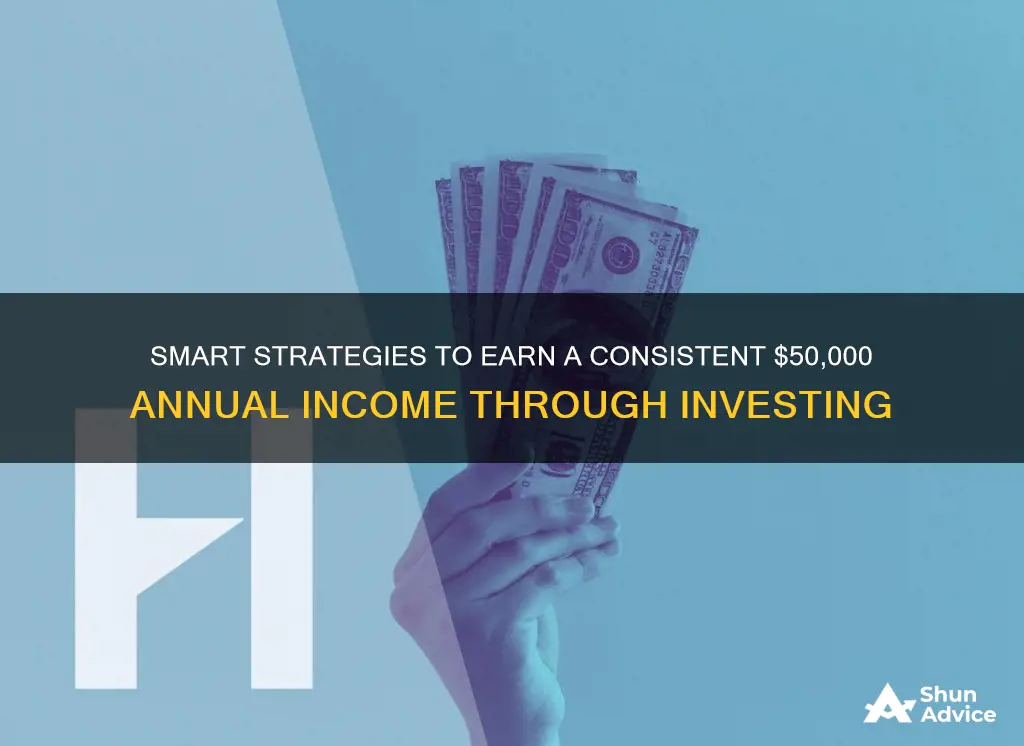
If you're looking to invest $50,000, there are a variety of options to consider. The best choice for you will depend on your financial goals, risk tolerance, and time horizon. Here are some popular investment options to get you started:
- Retirement accounts: Maxing out contributions to a 401(k) or IRA can be a tax-efficient way to save for retirement. In 2024, the contribution limit for a 401(k) is $23,000, while the limit for an IRA is $7,000 ($8,000 if you're 50 or older).
- Health Savings Account (HSA): An HSA allows you to set aside pre-tax money for healthcare costs. Contributions are tax-deductible, and money can be invested to grow over time. The 2024 contribution limit for an HSA is $4,150 for self-only coverage or $8,300 for family coverage.
- 529 college savings plan: Funding a 529 plan is a tax-efficient way to save for a child's education. While contributions aren't deductible at the federal level, many states offer tax benefits. The money can be used for qualified education expenses, including tuition, fees, books, and room and board.
- High-yield savings accounts and Certificates of Deposit (CDs): These are low-risk options that offer moderate returns. Savings accounts provide easy access to your funds, while CDs offer higher interest rates but require you to leave your money untouched for a specified term.
- Treasury securities: These are low-risk securities issued by the U.S. government, including Treasury bills, notes, and bonds. Treasury bills mature in less than a year, while notes and bonds have longer maturities.
- Index funds: Index funds offer broad diversification and attractive returns by tracking a specific market index, such as the S&P 500. They tend to have low costs and have historically outperformed actively managed mutual funds.
- Robo-advisors: Robo-advisors use algorithms to build and manage a diversified portfolio based on your goals and risk tolerance. They are a good option for those who want a hands-off approach to investing.
- Brokerage account: Opening a brokerage account gives you access to a wide range of investment options, such as stocks, bonds, mutual funds, and ETFs. You can choose from various brokers offering different features and services to meet your needs.
- Alternative investments: Alternatives include precious metals, cryptocurrencies, real estate, and collectibles. These can be more complex and risky but offer potential for diversification and higher returns.
| Characteristics | Values |
|---|---|
| Investment Type | High-yield savings account, Certificate of Deposit (CD), Money Market Account, Corporate Bond Fund, Government Bond, Mutual Fund, Exchange-Traded Fund (ETF), Rental Property, Treasury Bills, Notes and Bonds, Index Fund, Cryptocurrency, Art, Annuity |
| Interest Rate | 0.39% to 6%+<co: 5>/co: 5> |
| Investment Amount | <co: 0,1,2,3,4,5>$50,000 |
| Risk | Varies depending on the investment type |
| Liquidity | Varies depending on the investment type |
| Time Period | Varies depending on the investment type |
| Access to Funds | Varies depending on the investment type |
What You'll Learn

Investment accounts
Overview:
Types of Investment Accounts:
- Brokerage Account: A brokerage account is a versatile option, allowing you to invest in stocks, bonds, exchange-traded funds (ETFs), and mutual funds. You can choose from a variety of brokerage firms, each offering unique features like sophisticated trading platforms and educational resources.
- Individual Retirement Account (IRA): An IRA is a special type of brokerage account tailored for retirement savings. It offers tax advantages, with two main types: Traditional IRAs provide tax-deductible contributions, while Roth IRAs offer tax-free withdrawals (but no deduction for contributions). In 2024, contribution limits are $7,000 for those under 50 and $8,000 for those 50 and older.
- Health Savings Account (HSA): An HSA is an often-overlooked investment tool that pairs well with a high-deductible health insurance plan. It offers tax-deductible contributions and tax-free withdrawals for qualified healthcare expenses. In 2024, contribution limits are $4,150 for self-only coverage and $8,300 for family health coverage.
- Savings Account or Certificate of Deposit (CD): These accounts offer a more conservative approach, prioritising capital preservation. Savings accounts provide easier access to your funds but with fluctuating interest rates. CDs lock in a higher interest rate for a fixed term but impose penalties for early withdrawals.
Diversification and Risk Management:
When investing, it's essential to consider your risk tolerance and investment horizon. If you're investing for the long term, you can allocate more to stocks and stock funds, which historically deliver higher returns but come with volatility. For shorter-term goals, safer options like bonds, CDs, and high-yield savings accounts are preferable, as they provide regular income and reduce portfolio risk.
Robo-Advisors and Financial Advisors:
If you'd rather delegate investment management, you can choose from robo-advisors or human financial advisors. Robo-advisors use algorithms to manage your portfolio based on your goals and risk tolerance. In contrast, human advisors offer a more personalised service but tend to charge higher fees.
In conclusion, investment accounts are a fundamental tool for achieving your financial goals. They provide a means to effectively manage and grow your wealth, offering various options to suit diverse needs and risk profiles. When selecting investment accounts, it's crucial to consider the tax implications, level of risk, and level of access to your funds.
Retirement Planning: The Young Investor's Dilemma
You may want to see also

Low-cost investments
Investment Accounts
Investment accounts are a great place to start when looking for low-cost investment opportunities. These accounts offer tax benefits that can help maximise your returns. For example, you can add $7,000 to a Roth IRA and put the remaining funds in a traditional brokerage account. If you're saving for a college fund, 529 college savings plans are also a great option as they are subject to the annual gift tax exclusion.
Low-Cost Investment Vehicles
When investing for the long term, it's important to consider low-cost investment options to ensure your returns aren't eaten up by fees. Actively managed mutual funds often come with high expense ratios, so it's worth exploring other options. Index funds, for instance, allow you to invest in a wide range of companies at once while reducing the risk associated with investing in a single stock.
Diversify Your Assets
With a sum of $50,000, you can easily diversify your portfolio to manage risk. Explore investments across different sectors and geographies, such as clean energy ETFs, tech stocks, or China ETFs. You can also look into funds that hold small-to-medium-sized companies or those that focus on international and emerging markets.
Maximise Retirement Accounts
If your employer offers a 401(k) plan with matching contributions, consider using your $50,000 to free up your budget and maximise this benefit. Traditional and Roth IRAs are also great tax-advantaged options for retirement savings. While these accounts have annual contribution limits, they offer tax benefits that can boost your overall returns.
Optimise for Tax Efficiency
When adding new investments to your portfolio, consider their tax efficiency. Hold investments with low tax burdens, such as stock index funds and municipal bond funds, in a taxable brokerage account. Investments that generate ordinary income or capital gains tax, like corporate bond funds, are better held in tax-deferred accounts like traditional IRAs or 401(k)s.
Look Beyond Retirement
While retirement is an important financial goal, don't forget about other milestones like saving for a house down payment or your children's education. A windfall can help accelerate these goals, so consider allocating a portion of your $50,000 towards them.
Consult a Financial Advisor
If you're feeling overwhelmed or simply want expert guidance, consider consulting a financial advisor. They can provide personalised advice and help you navigate more complex investment strategies. Online financial advisors, like Vanguard Personal Advisor, offer similar services at a fraction of the cost of traditional advisors.
Remember, there is no one-size-fits-all approach to investing. It's important to consider your financial goals, risk tolerance, and time horizon when making investment decisions.
Gush: A Worthy Investment?
You may want to see also

Diversification
The three main general asset classes in an investment portfolio are stocks, bonds, and cash or cash equivalents. Stocks offer the highest long-term gains but are volatile, especially in a cooling economy. Bonds pay interest to investors who lend money to a company or government and are usually weaker during an expanding economy. Cash or cash equivalents, such as savings accounts, have low risk and low returns.
You can further diversify by breaking these categories down into subcategories. For example, within stocks, you can diversify by industry, company size, and geography. Within bonds, you can diversify by creditworthiness, bond issuer, and term length.
You can also diversify beyond traditional asset classes by investing in alternative investments such as real estate, precious metals, or cryptocurrency. Additionally, consider investing in products with guaranteed income streams, such as pensions, annuities, or insurance.
Reducing Risk Through Diversification
While diversification can reduce risk, it cannot eliminate it completely. Investments are subject to market risk, which affects all assets, and asset-specific risks, which are unique to individual investments or companies. Diversification helps protect your portfolio from the latter by ensuring you are not overly exposed to any one particular investment or sector.
How to Diversify Your Portfolio
You can diversify your portfolio by investing in a variety of securities, such as mutual funds, index funds, or exchange-traded funds (ETFs). These funds allow you to invest in a collection of securities, providing instant diversification. You can also use a robo-advisor, which can help automate the diversification process.
Remember, the key to successful investing is balancing your comfort level with risk against your time horizon. Diversification can help you achieve this balance by mitigating the impact of market volatility on your portfolio.
Who Invests and Why?
You may want to see also

Retirement accounts
K)
A 401(k) is a popular retirement account option, especially if your employer offers a match on contributions. This means that if your company offers a dollar-for-dollar match up to a certain percentage of your salary, you can maximize this benefit by contributing at least that percentage. For example, if your company matches up to 5% of your salary, contribute at least that much to take full advantage. In 2024, the contribution limit for a 401(k) is $23,000, or $30,500 if you're 50 or older.
Individual Retirement Account (IRA)
An IRA is another tax-advantaged way to save for retirement. You can choose between a traditional IRA and a Roth IRA. With a traditional IRA, you can make tax-deductible contributions, but withdrawals in retirement will be taxed as income. On the other hand, with a Roth IRA, you contribute with after-tax dollars, but qualified withdrawals in retirement are tax-free. The contribution limits for IRAs in 2024 are $7,000, or $8,000 if you're 50 or older.
Health Savings Account (HSA)
An HSA is a less well-known but valuable investment tool. It's a tax-deductible savings account for healthcare expenses that can also be used for retirement. Contributions are tax-deductible, and withdrawals are tax-free if used for qualified medical expenses. If you're 65 or older, you can withdraw funds for any reason, but non-medical withdrawals will be taxed as income. For 2024, the contribution limits are $4,150 for self-only coverage or $8,300 for family coverage.
Savings Accounts and Certificates of Deposit (CDs)
While these options may not provide the highest returns, they are a safe and reliable way to protect your principal. Savings accounts typically offer easy access to your funds, but the interest rates can fluctuate over time. CDs, on the other hand, offer a fixed interest rate for a specified period, usually higher than savings accounts, but you must commit to keeping your money deposited for that time.
Brokerage Account
If you want to invest in stocks, bonds, exchange-traded funds (ETFs), or mutual funds, you'll need a brokerage account. There are many brokerage firms offering accounts with different features, so it's important to compare several options to find the best fit for your needs.
Remember, it's important to consider your financial goals, risk tolerance, and time horizon when choosing the right retirement accounts for you. Diversifying your savings across different types of accounts can also help balance risk and maximize returns. Additionally, consider seeking advice from a financial advisor to create a personalized plan.
Young Investors: Why the Hesitation?
You may want to see also

Tax-efficient investments
There are two main types of investment accounts: taxable and tax-advantaged. Taxable accounts, such as brokerage accounts, offer more flexibility than tax-advantaged accounts. The returns are taxed according to how long the asset was held before being sold. If held for longer than a year, investments are subject to long-term capital gains tax rates of 0%, 15%, or 20%, depending on the investor's tax bracket. If held for a year or less, they are taxed according to the investor's ordinary income tax bracket.
Tax-advantaged accounts can be tax-deferred or tax-exempt. Tax-deferred accounts, such as traditional IRAs and 401(k) plans, provide upfront tax breaks, but investors pay taxes when they withdraw their money in retirement. In contrast, tax-exempt accounts, including Roth IRAs and Roth 401(k)s, are funded with after-tax dollars, but investments grow tax-free, and qualified withdrawals in retirement are tax-free. These accounts have restrictions and penalties for withdrawals before retirement age.
- Tax-loss harvesting: This involves selling investments at a loss to offset taxable capital gains. This strategy can help reduce taxes owed on investment gains.
- Municipal bonds: Municipal bonds, or "munis," are tax-efficient because the interest income is typically exempt from federal income tax and may also be exempt from state and local taxes. They are a good option for taxable accounts.
- Index funds and ETFs: Index funds and exchange-traded funds (ETFs) tend to be tax-efficient due to their low turnover, resulting in fewer capital gains distributions. They are a good option for investors seeking diversification and long-term growth.
- Tax-managed funds: These funds actively manage their portfolios to minimize capital gains distributions and maximize tax efficiency. They are suitable for investors in higher tax brackets.
- Individual stocks: Holding individual stocks in a taxable account can be tax-efficient, especially if you trade infrequently. This allows you to control when you realize capital gains or losses for tax purposes.
- Diversification by tax treatment: Consider holding investments with different tax treatments, such as taxable brokerage accounts, tax-deferred accounts (traditional IRA, 401(k)), and after-tax Roth accounts. This strategy can provide flexibility in managing taxes during retirement, regardless of your future tax bracket.
- Qualified dividend-paying stocks and funds: Qualified dividends are generally taxed at lower rates than ordinary income. Holding these investments in taxable accounts can be more tax-efficient.
- Real estate investment trusts (REITs): REITs can provide exposure to the real estate market and offer potential income and capital appreciation. They are typically held in taxable accounts.
- Health Savings Account (HSA): An HSA is a tax-deductible savings account for healthcare expenses. Contributions are tax-deductible, and withdrawals for qualified healthcare expenses are tax-free. It offers a way to save for healthcare costs while also growing your investments.
Seeking Investors for Your Farm?
You may want to see also
Frequently asked questions
The safest way to invest $50,000 is to put it into a savings account or CD.
The interest earned depends on the investment and the yield. As a general rule, every 1% yield in a savings account or CD will result in $500 in interest per year if you start with $50,000.
The best way to invest $50,000 depends on a few factors, including age, risk tolerance, and financial goals. But for most people, the best way to invest is some combination of fixed-income instruments (like bonds, CDs, or high-yield savings accounts) and stock-based investments that typically deliver the highest returns over long periods.







